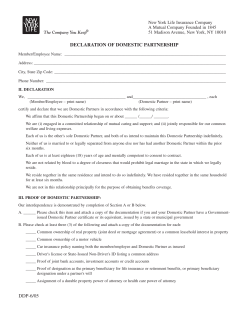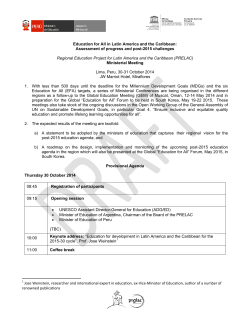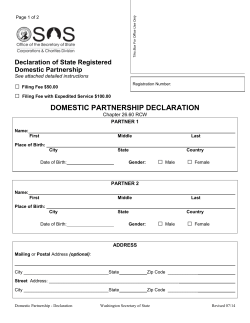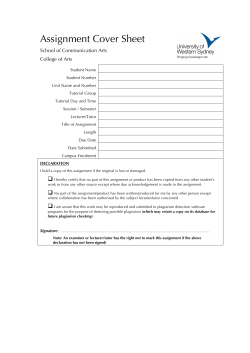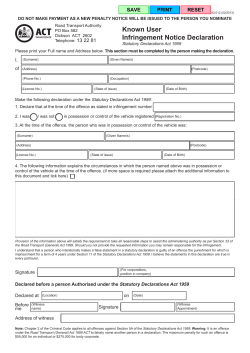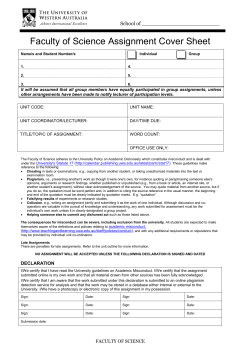
Debapriya Bhattacharya - United Nations Sustainable Development
Towards a UN Declaration in the Context of Post-2015 Development Agenda - A Check List by Debapriya Bhattacharya, PhD Chair, Southern Voice on Post-MDGs and Distinguished Fellow, Centre for Policy Dialogue (CPD) Presentation made at the first session of inter-governmental negotiation on Post-2015 Agenda United Nations, New York: 20 January, 2015 2 I. Elements of a Declaration in the UN Context? Declaration is an explicit, positive and formal announcement, (usually written). Declaration has a methodical and logical form stating the (social, economic, environmental and political) circumstances (“the big thought”) which constitute the cause(s) of action. Declaration espouses a set of guiding principles motivating the cause of action. Declaration usually contains the modalities and measures to be followed in realizing the objectives of the stated action(s). Declaration may indicate methods to assess the effectiveness of the contemplated action(s). Deb Bhattacharya: Post-2015 Declaration 3 2. Learning from the Millennium Declaration Framework Reiteration of Values and Principles Guided by the purposes and principles of the Charter of the United Nations which aims at building a more peaceful, prosperous and just world. Fundamental values include freedom, equality, solidarity, tolerance, respect for nature, shared responsibility WILL THERE BE MENTION OF ANY “NEW” VALUE OR PRINCIPLE OR ANY “TRADITIONAL” ONE BE HIGHLIGHTED? Expression of Political Intention to Pursue Some Objectives and Goals Reiterating the commitment to freeing humanity from poverty and hunger, ensuring healthy lives, achieving gender equality, reducing inequality and combating climate change, etc. Implement the rule of law in international and national affairs Providing UN with more resources to make it more effective in maintaining peace and security WHAT WOULD BE THE “DEFINING” POLITICAL INTENTION? WHAT WOULD BE THE “BIG”OBJECTIVE/GOAL? Deb Bhattacharya: Post-2015 Declaration 4 2. Learning from the Millennium Declaration Framework Highlights Some Priorities and Special Needs Protecting the refugees through coordination of humanitarian assistance Address the special needs of LDCs, by implementing the Istanbul Programme of Action (IPoA) Recognise the special needs and problems of the SIDS, LLDCs and African countries. ANY “NEWLY EMERGING” PRIORITY OR SPECIAL NEED? Institutional Approach toward Attaining the Objectives Comprehensive reform of the UN Security Council Strengthening further the Economic and Social Council and the International Court of Justice Ensuring greater policy coherence and better cooperation between the United Nations, its agencies, the Bretton Woods Institutions and the WTO, as well as other multilateral bodies Providing greater opportunities to private sector, NGOs and civil society WHAT “INNOVATION” RE DELIVERY MECHANISM? Deb Bhattacharya: Post-2015 Declaration 5 3. Content Issues for Post-2015 Declaration Universal, Transformative, Inclusive and Integrated Agenda – The BIG Idea? Universal agenda would address all countries and all citizens of the world remaining sensitive to their varying level of development and capacities as well as their structural handicaps. Transformative agenda deals with structural issues like productive capacities, value addition in different sectors, capacity building etc. – leading to sustainable employment and income generation. Inclusive growth ensures decent jobs, sustainable livelihoods and rising real incomes for all. It is not only measured by GDP but also include human well-being, sustainability and equity. Post-2015 agenda will be an integrated one which would frame goals and targets in a way that integrate their economic, environmental and social dimensions. Deb Bhattacharya: Post-2015 Declaration 6 3. Content Issues for Post-2015 Declaration How to adequately – conceptually and operationally - reflect these FOUR DIMENSIONS in the Declaration? The major challenge (among the four) would relate to “Universality” as the SDG architecture still remains “work under progress”. A critical question this regards would be will there be an identified set of Global Minimum Goals which would be relevant for all groups of countries? Refer findings of the SV study on Post-2015 Data Test. The declaration has to posit an incentive structure for the middle income countries (with their widely varying development interests). Deb Bhattacharya: Post-2015 Declaration 7 3. Content Issues for Post-2015 Declaration Objectives and goals are to be derived from specific paragraphs of the Declaration on Principles and Political Intentions, not the other way round. The concern re the second approach arises as the Goal setting is at a developed stage thanks to a wide ranging consultative and dedicated processes. Certain empirical goals and targets as expression of overriding political commitment may be mentioned in the Declaration. May be one each from economic, social and environment sectors. Deb Bhattacharya: Post-2015 Declaration 8 3. Content Issues for Post-2015 Declaration Objectives and goals contained in the Declaration may be more ambitious than the specific SDGs and the targets. Declaration thus should accommodate the overreaching objectives which could not be included in the SDGs due to practicality. Can one support (politically) the Declaration but not the SDGs or the other way round? We had such situations in case of Millennium declaration. Deb Bhattacharya: Post-2015 Declaration 9 3. Content Issues for Post-2015 Declaration There has to be space and flexibility for the Indicators of the SDGs to be agreed later. This aspect becomes particularly given that SDGs will be “universal but with country sensitivity”. This would be also necessary to accommodate “special needs and priorities”. The Declaration needs to mention the baseline (2000, 2005 or 2010?) for the SD Goals and Targets which may raise some sequencing issue re later determination of the indicators. A good assessment of the availability of data for all countries according to goals and targets as well as other considerations (e.g. GFC) is essential to determine the baseline. Mention findings of SV study on Post-2015 Data Test. Deb Bhattacharya: Post-2015 Declaration 10 4. Framework Issues for the Post2015 Declaration The Framework of the Declaration would determine effectiveness of the agreed goals and targets. The important aspects, inter alia, are Resource Provisioning, Accountability Mechanism, Participation of the non-State actors (including Business), Monitoring and Review as a part of a roadmap for full and faithful delivery of the commitments should be included in declaration in terms of goals and targets. It is not expected that the Declaration would mention the wideranging Means of implementations (MoIs) which have been already identified. However, operational aspects of the Global Partnership have to be spelt out. Deb Bhattacharya: Post-2015 Declaration 11 4. Framework Issues for the Post- 2015 Declaration Resource Framework. Monterrey Conference was held after adoption of the MDGs. Thankfully, SDGs will be endorsed when the outcome of the Addis Abba FfD meeting will be at hand. Moreover, global conversation on sustainable development finance is progressing with inputs from the Intergovernmental Committee of Experts on Sustainable Development Financing. The Declaration needs to contain credible and meaningful resource commitments for realising the SDGs. These resources will be aid and beyond, finance and beyond. Deb Bhattacharya: Post-2015 Declaration 12 4. Framework Issues for the Post2015 Declaration Accountability Mechanism. A comprehensive accountability framework had been a major missing component in the MDG Declaration. The demand on the accountability mechanism has further increased with the added complexity of the agenda as well as inclusion of many more actors. Need for strengthening the regional level institutions as well as integration of the non-state actors (including business) have become important. A multi-tiered and innovative accountability mechanism is a prerequisite for effective implementation of the post-2015 framework Deb Bhattacharya: Post-2015 Declaration 13 4. Framework Issues for the Post- 2015 Declaration Monitoring and Review. The dual challenge of the monitoring and review process of the post-2015 agenda is to be effectively comprehensive, without adding further pressure on the countries with limited capacity. With agenda becoming increasingly multi-stakeholder driven, it is important to creatively reflect this aspect in the monitoring and review process. It is expected that the Declaration would put due emphasis on need to invest in generating real time quality data enabling the monitoring of the progress achieved under the SDG dispensation. Deb Bhattacharya: Post-2015 Declaration 14 4. Framework Issues for the Post2015 Declaration Avenues for Participation of Multiple Stakeholders. The preparatory process of the post-2015 agenda has established a good tradition of open and constructive engagement of wide-ranging institutions individuals in shaping the SD goals and targets. This practice now needs to be extended so that, among others, parliamentarians, LG representatives, trade bodies and NGOs/CSOs may find an avenue to effectively channel their inputs in the implementation process. The Declaration has to give specific mandate and guidelines re engagements of the non-state actors in the delivery of post-2015 agenda. Deb Bhattacharya: Post-2015 Declaration 15 4. Framework Issues for the Post- 2015 Declaration One of the critical framework issues relate to the governance structure of the post-2015 development agenda. Obviously, the adjustments of traditional entities (SD Commission and ECOSOC) remain incomplete, whereas role of emerging bodies (High Level Political Forum) is yet to be fully established . The Declaration has to give a fuller understanding about the new architecture which will lead, coordinate and review the post-2015 processes. Deb Bhattacharya: Post-2015 Declaration 16 5. Global Partnership – a core aspect of the Declaration MDG 8, according to wide recognition is the “weakest link” of the Millennium Agenda. Tweaking of the Goal 8 based on disparate afterthoughts did not help much in overcoming the deficiencies. Post-2015 Declaration has to fix this historical (conceptual, if not political) shortfall. This would be the major measure of credibility of the post-2015 initiative (campaign). While reiterating commitments to address the unfulfilled promises (including in the area of ODA), the “global partnership for effective development” (GPEDC) has to make space for flow of non-traditional resources (e.g. domestic revenue, international private capital, blended and innovative finance), new actors (particularly through South-South and South-SouthNorth cooperation) and new institutions (e.g. BRICS Bank and China Infrastructure Fund). Deb Bhattacharya: Post-2015 Declaration 17 5. Global Partnership – a core aspect of the Declaration Establishing Complementary Relationship with other International Parallel Process. The substance Global Partnership has come to a large extent from successful completion of a number of parallel international processes including in the areas of trade (WTO), climate (UNFCC), international taxation (OECD), intellectual property rights (WIPO), global financial rules (???) . Without efficiency gains achieved in these areas, not only it will be difficult to achieve SDGs, but may lead to erosion of earlier progress. Pointing out the complementary nature of these negotiations, the Declaration on post-2015 agenda has to provide strong instructions re yielding development-friendly outcomes under them at the earliest. Deb Bhattacharya: Post-2015 Declaration 18 5. Global Partnership – a core aspect of the Declaration Establishing Coherence with other International Programmes for Countries with Special Situations Under the auspices of the UN, there are a number of global partnership programmes adopted in favour of, among others, LDCs, SIDS and LLDCs. The declaration need not do a proforma mention of these global partnership programmes, but provide effective guidance re delivery of the commitments made under them (which are partly related to above). Deb Bhattacharya: Post-2015 Declaration 19 6. Between Rhetoric and Realities History has witnessed on many occasions when progressive rhetoric has been often used to conceal social crisis and/or stagnancy of established order. The issue is whether the UN Declaration on Post-2015 Development Agenda be one of those unfortunate cases? Or, will it forewarn the birth pangs of emergence of a new set of realities leading to a more freer and fairer world based on tolerance, solidarity and shared responsibility? What can bridge the apprehended gap between rhetoric and reality is revealed collective political will of our leaders. Only time will say how lucky the world has been in this regard in the post-2015 period. Deb Bhattacharya: Post-2015 Declaration 20 Good Luck and Thank You <debapriya.bh@gamail.com> Deb Bhattacharya: Post-2015 Declaration
© Copyright 2025
